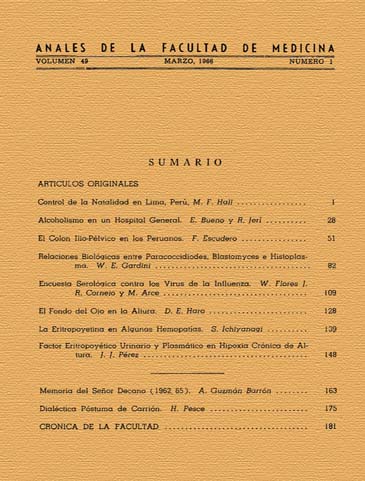Erythropoietic factor and Plasma Volume in Chronic Hypoxia Height
DOI:
https://doi.org/10.15381/anales.v49i1.5569Abstract
This work has been initiated by the incessant concern about the research of erythropoietin, which corresponds to one of the large and important chapters of Hematology. This research work is developed in the Institute of Andean Biology, Faculty of Medicine, San Fernando, with a central laboratory in Lima, and another in the mining town of Morococha, to 4.540 meters above sea level, located in the Central Sierra of Peru. With the extensive facilities provided by the Institute, it has been possible to carry out this work, for which a group of six students of Medicine of the National University of San Marcos moved to that place for the collection of the work material. Thinking about the complicated mechanism of a plasma humoral factor, which since 1906 has been termed by Carnot and Deflandre, as haemopoietin; Grant later and Root (1) made a review regarding the fundamental stimulus of erythropoiesis at that erythropoietic stimulating substance Jalavisto Bonsdorlf and (2) have referred to as erythropoietin. In 1950 Reissmann (3) did parabióticas experiences in rats demonstrating erythropoietic stimulating factor, then place them in a hypoxic atmosphere.Downloads
Published
1966-03-14
Issue
Section
Trabajos originales
License
Copyright (c) 1966 Juan Julio Pérez Enciso

This work is licensed under a Creative Commons Attribution-NonCommercial-ShareAlike 4.0 International License.
Those authors who have publications with this magazine accept the following terms:
- Authors will retain their copyrights and guarantee the journal the right of first publication of their work, which will be simultaneously subject to Creative Commons Attribution License that allows third parties to share the work as long as its author and its first publication this magazine are indicated.
- Authors may adopt other non-exclusive licensing agreements for the distribution of the version of the published work (eg, deposit it in an institutional electronic file or publish it in a monographic volume) provided that the initial publication in this magazine is indicated.
- Authors are allowed and recommended to disseminate their work over the Internet (eg: in institutional telematic archives or on their website) before and during the submission process, which It can produce interesting exchanges and increase quotes from the published work. (See El efecto del acceso abierto ).
How to Cite
1.
Pérez Enciso JJ. Erythropoietic factor and Plasma Volume in Chronic Hypoxia Height. An Fac med [Internet]. 1966 Mar. 14 [cited 2024 Sep. 1];49(1):148-62. Available from: https://revistasinvestigacion.unmsm.edu.pe/index.php/anales/article/view/5569















